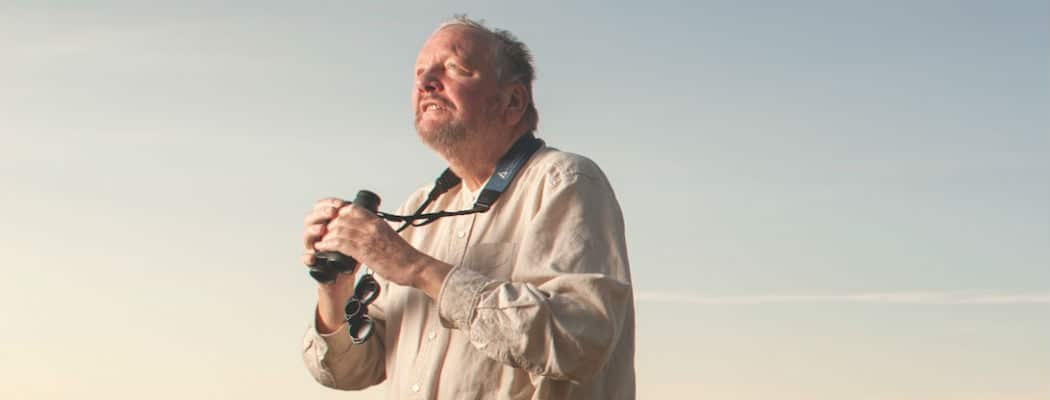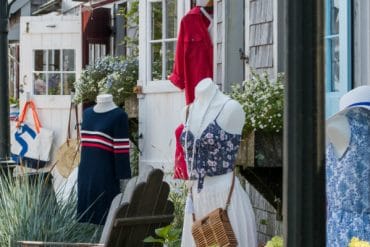The web exclusive extended version of N Magazine‘s story behind the internationally renowned birder, Vern Laux.
 “Imagine being able to fly?” Those words were posed to me by Vern Laux not necessarily as a question but more of an affirmation of his lifelong obsession with birds. Among the birding community of New England and beyond, Laux is something of a giant –both literally and figuratively. Go ahead and picture what you think a birder might look like, and it’s fair to say that he probably doesn’t fit the mold. A former football defensive lineman, sixty-year-old Vern Laux is a bear of a man who has spent most of his life learning all there is to know about the Earth’s fowl.
“Imagine being able to fly?” Those words were posed to me by Vern Laux not necessarily as a question but more of an affirmation of his lifelong obsession with birds. Among the birding community of New England and beyond, Laux is something of a giant –both literally and figuratively. Go ahead and picture what you think a birder might look like, and it’s fair to say that he probably doesn’t fit the mold. A former football defensive lineman, sixty-year-old Vern Laux is a bear of a man who has spent most of his life learning all there is to know about the Earth’s fowl.
“It’s the only reason I do anything,” he says. “I don’t go places if there aren’t tons of birds.” His fascination has taken him to all seven continents leading bird tours, but always back to New England, the region where he grew up and where he made a name for himself in the birding world. “Famous and infamous!” he says of his reputation with a laugh.
Birding has almost gotten him killed. Repeatedly. In search of birds, Laux has sidestepped land mines in the Falkland Islands. He’s been in the crosshairs of two Cobra gunships on Mount Hermon at the Israel-Syria border screaming, “don’t shoot!” And he’s survived an attack by a pod of leopard seals in Antarctica. “There’s people who think birding is for pansies?” he asked rhetorically. “You have to go to a lot of places where you have to be careful.”
After years of leading tours and tracking birds to all corners of the globe, Laux now shares his passion on Nantucket as the senior naturalist for the Linda Loring Nature Foundation. Thankfully, the island certainly meets his criteria as a place that has “tons of birds.” With the mind of ornithologist and the enthusiasm of a child, Laux leads bird walks from the foundation and spearheads the annual Nantucket Birding Festival every fall.
“Vern is bigger than life,” says acclaimed wildlife photographer and birder Kevin Karlson. Karlson first met Laux at the 1990 World Series of Birding, an annual event organized by the New Jersey Audubon Society. The two men have kept in touch over the years, occasionally meeting in person at various birding events and conferences around the country. Karlson was effusive about his old friend Vern who, he said, reminded him of Neal Cassady, the real-life inspiration for Jack Kerouac’s character Dean Moriarty in “On the Road.” “He affects people with his unbridled energy, and just pushes the limit and pushes the edge in everything he does,” Karlson said.
Sitting in the living room of his girlfriend’s home in Madaket in early September, Laux attempted to explain his obsession to me, a non-birder who never really understood what all the fuss was about. He led me to a scope pointed toward Hither Creek and a stand occupied by an osprey. “You know where that bird is going for the winter?” he asked. “It’s going south of the equator, to either Peru, Ecuador or further south where it’s going to spend all winter on some little tributary of the Amazon River learning to catch fish. I’m just fascinated by anything that flies… I wish I could fly, I guess is the answer.”
 If he had his way, Laux might be following that osprey south to Ecuador this winter, a place he has dubbed “Disneyland for bird watching.” Instead, he will likely be staying put on Nantucket, continuing on a very different kind of journey. On September 2, 2014, doctors at the Dana-Farber Cancer Institute informed Laux that they had discovered advanced esophageal cancer. They told him he had just three weeks to live. “I said, well, should I jump out the window now or should I wait awhile?” Laux remembers. “I felt like someone had taken a chainsaw and cut off my legs,” he said. “I never imagined I’d be here a year later.” And yet he is. Laux is still birding, still cracking jokes and still fighting the odds he was given.
If he had his way, Laux might be following that osprey south to Ecuador this winter, a place he has dubbed “Disneyland for bird watching.” Instead, he will likely be staying put on Nantucket, continuing on a very different kind of journey. On September 2, 2014, doctors at the Dana-Farber Cancer Institute informed Laux that they had discovered advanced esophageal cancer. They told him he had just three weeks to live. “I said, well, should I jump out the window now or should I wait awhile?” Laux remembers. “I felt like someone had taken a chainsaw and cut off my legs,” he said. “I never imagined I’d be here a year later.” And yet he is. Laux is still birding, still cracking jokes and still fighting the odds he was given.
After the initial diagnosis at Dana Farber, Laux sought a second opinion from a contact at the National Cancer Institute: Dr. Ira Pastan, the co-chief of the organization’s laboratory on molecular biology, or as Laux calls him, “God.” Pastan connected Laux with his colleagues at the Massachusetts General Hospital Cancer Center. The MGH oncologists now have Laux on a treatment regimen of chemotherapy and a monoclonal antibody drug that seems to be effective in shrinking his lesions and halting the advance of his cancer. And the partnership between the MGH Cancer Center and Nantucket Cottage Hospital has allowed Laux to stay on-island for nearly all of his treatment and consultations.
On a September morning at Nantucket Cottage Hospital, just before an IV-bag full of Benadryl put him asleep ahead of his chemotherapy treatment, I read Laux the news alert that pinged on my iPhone: New England Patriots quarterback Tom Brady’s “Deflategate” suspension had been vacated by a federal judge in New York City. Laux, a former high school football star, raised both hands in the air and let out a celebratory expletive. The powerful drugs being pumped into his body seem to be working, but have left Laux weak, his fingers numb, and down about 70 pounds. His sense of humor, however, is still intact. “I got bit by a mosquito the other day and it died,” he said. “I have the most expensive chemical bug repellent in the world! You want that blood? I don’t think so.”
A native of Wellesley, Massachusetts, E. Vernon Laux describes himself as a “big jock and kind of a wise guy” growing up. That he got into birding at all was unlikely. It was an eighth grade science teacher who introduced him to a chart of New England’s winter birds for a quiz. Laux flunked. “I thought it was a joke,” he said. Then the teacher brought a dead bird to class and offered an A to the student who could identify it. That was enough of an enticement for Laux to seek out the help of a neighbor who was a birder. The man spent an hour and a half with Laux and gave him his first field guide. In the end, Laux didn’t get the A, but he still remembers when the teacher identified the bird — a Virginia rail.
 “It got me paying attention to things. I went on my first Christmas bird count with a much more experienced birder, and I’m in the eighth grade, it’s freezing cold, and I saw a cedar waxwing,” he remembered. “I never knew a bird could be so great looking. It really just kind of struck a chord with me and set me off.”
“It got me paying attention to things. I went on my first Christmas bird count with a much more experienced birder, and I’m in the eighth grade, it’s freezing cold, and I saw a cedar waxwing,” he remembered. “I never knew a bird could be so great looking. It really just kind of struck a chord with me and set me off.”
Being the only birder on his high school football team in the late 1960s and early 1970s, however, went over as you might expect. Laux’s teammates didn’t exactly understand his new hobby. Thankfully, he was big enough to take care of himself. “I was a defensive tackle, and in my sophomore year, three seniors grabbed me and we got in a big fight in the showers,” he said. “And I bloodied them all. Then, I hunted them the rest of the year on the field. I was getting bigger and stronger every week. Pretty soon, they left the bird watcher alone.”
Through an internship at Mass Audubon’s Wellfleet Bay Wildlife Sanctuary on Cape Cod, Laux indulged his growing fascination with birds during the rest of his high school years. By the time he was preparing for college, Laux had very different goals than his contemporaries. “I wanted to see all the birds in North America by the time I got out of college,” he said.
 After two years at Cape Cod Community College and a brief stint as a laborer on a National Oceanic and Atmospheric Administration boat out of Alaska, Laux found himself at the University of Arizona. It was there in the desert southwest that Laux met some of his greatest influences and colleagues in the world of ornithology, a handful of men who would go on to make their own mark on the birding world.
After two years at Cape Cod Community College and a brief stint as a laborer on a National Oceanic and Atmospheric Administration boat out of Alaska, Laux found himself at the University of Arizona. It was there in the desert southwest that Laux met some of his greatest influences and colleagues in the world of ornithology, a handful of men who would go on to make their own mark on the birding world.
Among them was the late Ted Parker, considered one of the best ornithologists in the world before his death in a plane crash in 1993; Kenn Kaufmann, the noted field guide author, artist and naturalist; as well as University of Kansas professor and evolutionary biologist Mark Robbins. Laux met all of them in Tucson, a place he was drawn to not only because he needed to check the birds of the desert southwest off his bucket list, but also because it represented the gateway to South America. Laux met all of them in Tucson, a place he was drawn to not only because he needed to check the birds of the desert southwest off his bucket list, but also because it represented the gateway to South America. “There was really nothing known about birds south of the border,” Laux said. “There were no field guides to anywhere in South America. It was like unexplored territory. This was the real beginning, and I wanted to get in on that, you know?”
Laux eventually left Tucson without a degree, mostly because he wasn’t learning anything he didn’t already know. After returning east, he settled on Martha’s Vineyard where he worked in the airline and real estate industries and started a family. His two children, Lily and Edward, were born on the island. Through it all, of course, he continued birding.
After years of leading tour groups all over the globe and publishing his book Bird News in 1999, the highlight of Laux’s birding life came in 2004 on the Vineyard, when a chance encounter would thrust his name onto the front page of the New York Times. On a mid-summer morning, Laux spotted an unusual bird near the Katama airfield. A small falcon, he thought, perhaps an American kestrel or maybe a Mississippi kite? It was right in his backyard, but Laux was initially stumped and, it turns out, for good reason. The bird had never been seen before in the western hemisphere. It was a red-footed falcon, a bird of prey that migrates between Europe and Africa and was thousands of miles from where it should have been. “It was like a Martian walking around among humans,” Laux said. “There had never been one in the Americas, north or south. Nobody’s looking for it, no one has ever even heard of it. It’s not in any of the field guides. This caused an absolute furor.”
 The Vineyard briefly became the birding capital of North America as ornithologists and birders from all over the country descended on the island to catch a glimpse of the red-footed falcon. The story was picked up by national media outlets, and Laux started getting congratulatory letters from as far away as Australia. “It was crazy,” he remembers. “We’re on a public road to the best beach on the island, so it was birders, girls in bikinis, and news crews. Channel Four came in on a helicopter and almost killed it. They got out and I started screaming at them. Even Walter Cronkite got a look at it.”
The Vineyard briefly became the birding capital of North America as ornithologists and birders from all over the country descended on the island to catch a glimpse of the red-footed falcon. The story was picked up by national media outlets, and Laux started getting congratulatory letters from as far away as Australia. “It was crazy,” he remembers. “We’re on a public road to the best beach on the island, so it was birders, girls in bikinis, and news crews. Channel Four came in on a helicopter and almost killed it. They got out and I started screaming at them. Even Walter Cronkite got a look at it.”
Looking out the window back in Madaket, Laux recalls the episode with giddiness, like he does with all of his tales from the field. More than a full year after learning he has cancer, Laux is still leading weekly birding walks from the Linda Loring Nature Foundation’s headquarters on Eel Point Road and filing the “Weekly Bird Report” for WCAI, the Cape and Islands’ NPR station. His outlook on life and the challenges ahead seems to be appropriately captured in his signature radio sign-off: “Keep your eyes to the sky.”






